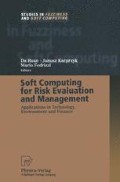Abstract
We design a fuzzy model of the loadings of heavy metals for two coastal areas of the Irish Sea (Liverpool Bay and Morecambe Bay). Each metal concentration is associated with a fuzzy set “contaminated” , defined over a set of sampling sites (70 in Liverpool Bay and 203 in Morecambe Bay). The higher the concentration, the higher the degree of membership of the site. Six overall loading indices are calculated using aggregation connectives between fuzzy sets. The loading indices are then interpolated and plotted on a map. A visual inspection shows that: (i) product aggregation is most indicative for the locations of the disposal grounds; (ii) mean aggregation reflects well the sediment movement in the bay; (iii) maximum aggregation indicates all highly contaminated sites. The proposed fuzzy model is easy to implement and the results are directly interpretable.
Access this chapter
Tax calculation will be finalised at checkout
Purchases are for personal use only
Preview
Unable to display preview. Download preview PDF.
References
T.C. Bailey. A review of statistical spatial analysis in geographical information systems. In A.S. Fotheringham and P.A. Rogerson, editors, Spatial analysis and GIS, pages 13–44. Taylor & Francis, London, 1994.
J.C. Bezdek and L.I. Kuncheva. Fuzzy pattern recognition. In J.G. Webster, editor, Wiley Encyclopedia of Electrical and Electronics Engineering, pages 173–181. John Wiley and Sons, Inc., Publishers, 1999.
I. Bloch. Information combination operators for data fusion: a comparative review with classification. IEEE Transactions on Systems, Man, and Cybernetics–Part A: Systems and Humans, 26: 52–67, 1996.
V.F. Camacho-Ibar.Trace elements and polychlorinated biphenyls (PCB) congeners in Liverpool bay sediments. PhD thesis, University of Wales, Bangor, 1991.
V.F. Camacho-Ibar, J.J. Wrench, and P.C. Head. Contrasting behaviour of arsenic and mercury in liverpool bay sediments. Estuarine, Coastal and Shelf Science, 41 (3): 241–263, 1992.
D. Dubois and H. Prade. A review of fuzzy set aggregation connectives. Information Sciences, 36: 85–121, 1985.
D. Dubois and H. Prade. The three semantics of fuzzy sets. Fuzzy Sets and Systems, 90: 141–150, 1997.
R.O. Duda and P.E. Hart. Pattern Classification and Scene Analysis. John Wiley & Sons, NY, 1973.
A.S. Fotheringham and P.A. Rogerson, editors. Spatial Analysis and GIS. Taylor & Francis, London, 1994.
M. Grabisch. A new algorithm for identifying fuzzy measures and its application to pattern recognition. In Proc. FUZZ/IEEE’95, pages 145150, Yokohama, Japan, 1995.
M. Grabisch. On equivalence classes of fuzzy connectives–the case of fuzzy integrals. IEEE Transactions on Fuzzy Systems, 3 (1): 96–109, 1995.
J.A. Markus and A.B. McBratney. An urban soil study: Heavy metals in Glebe, Australia. Australian Journal of Soil Research, 34: 453–465, 1996.
R.R Yager and D.P. Filev. Essentials of Fuzzy Modeling and Control. John Wiley & Sons, N.Y., 1994.
L.A. Zadeh. Fuzzy sets. Information and Control, 8: 338–353, 1965.
Author information
Authors and Affiliations
Editor information
Editors and Affiliations
Rights and permissions
Copyright information
© 2001 Physica-Verlag Heidelberg
About this chapter
Cite this chapter
Kuncheva, L.I., Wrench, J., Jain, L.C., Al-Zaidan, A. (2001). A Fuzzy Model of Heavy Metal Loadings in Marine Environment. In: Ruan, D., Kacprzyk, J., Fedrizzi, M. (eds) Soft Computing for Risk Evaluation and Management. Studies in Fuzziness and Soft Computing, vol 76. Physica, Heidelberg. https://doi.org/10.1007/978-3-7908-1814-7_18
Download citation
DOI: https://doi.org/10.1007/978-3-7908-1814-7_18
Publisher Name: Physica, Heidelberg
Print ISBN: 978-3-662-00348-0
Online ISBN: 978-3-7908-1814-7
eBook Packages: Springer Book Archive

